
Tucked away in the University’s strategic plan, “lurking behind a roman numeral, an Arabic numeral, and two lower-case letters in parentheses,” as President Edward L. Ayers joked at Colloquy in September, is a promise. The text is so buried, the language so dry, that it’s easy to miss.
But the promise is significant. It says that Richmond will provide students with opportunities for summer internships and research, either domestically or abroad, regardless of their financial circumstances.
It’s not that students don’t have these experiences in the summers and throughout the year. Many do, every semester across campus. You’ll meet nine of them in the pages that follow, some funded by the University and some not.
With more funding, all students who want them could be having such unique, powerful experiences.
Graduate school and career opportunities for students are increasingly being shaped by what they learn and do beyond the classroom, whether in a lab or a library, in an office or the field. Our admission policies are need-blind; opportunity for students on campus should be too. That’s the power of the promise.
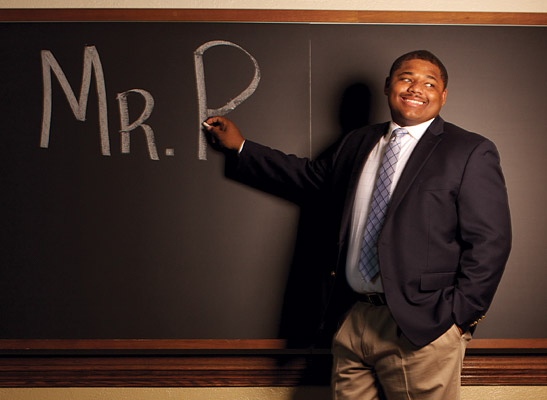
The Role Model
Ronwyn Pritchett, ’13
Martinsville, Va.
Look at that face. Big, friendly, warm. Ronwyn Pritchett has the personality to match—outsized, easy-going, full of life. So when he tells you that as a kid his mouth ran ahead of his maturity and got him in all kinds of trouble, it’s not hard to imagine.
For most of Pritchett’s life, his dad has been in a care facility, the victim of a stroke. After eighth grade, Pritchett found the male role models he craved in his coaches and became a three-sport star, proudly opening dozens of letters from big-time football programs by his sophomore year.
Then one day his principal told him, “You know you’re not going to college, right?” He didn’t know, but she was right.
His grades were barely enough for high school. He buckled down, excelled, and earned a spot at UR, where he devotes his talent and drive to helping other boys growing up without strong male role models.
Through a program called Higher Achievement, he spent the summer teaching social studies at Henderson Middle School in Richmond’s Northside. His gregarious personality caught students’ attention and kept learning fun, but he also offered consistency, discipline, and high expectations, qualities he’s researching as part of a thesis.
“You can’t save everyone, but you can’t give up on anyone,” he says. He knows what he’s talking about.
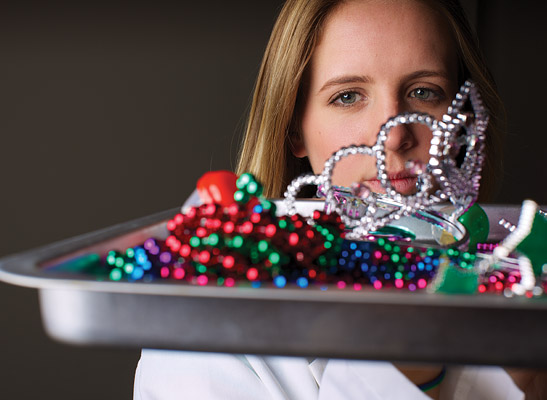
The Investigator
Margot Hillyer, ’14
Atlanta
Sparkly magic wands. Girly hair clips. Beads, necklaces, and charms. If she had the mind to do it, Margot Hillyer could’ve thrown the best princess party on campus.
What she actually did was far more interesting: dropping the toys into nitric acid, atomizing them, and using atomic absorption spectrophotometry to analyze their parts per million and billion of cadmium, arsenic, and lead. More than a quarter of the toys she tested exceeded federal limits. When ingested by children, they can, and sometimes do, kill.
The toys she tested—bargain store specials, the cheapest of the cheap—often wind up in the hands of kids from low-income families, giving her research a social imperative. She is thinking scientifically and socioeconomically for the long term, too, contemplating an M.D./Ph.D. career path that offers a broad- based approach to children’s health.
“There is not one path to being a doctor,” she says. “We don’t necessarily want doctors who are superscientists. We need people who are well-rounded. The best candidate might be someone who took the time to understand what people are actually buying and why it’s making them sick.”
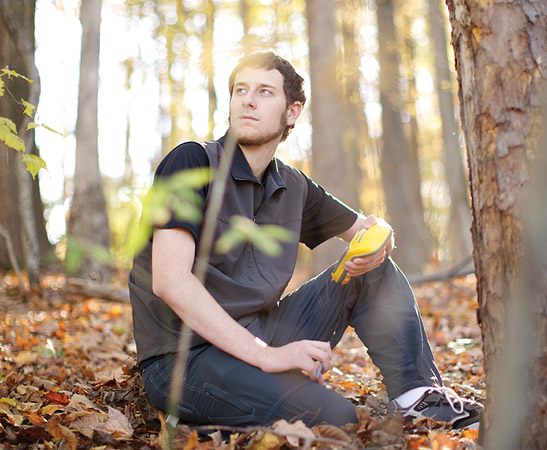
The Outdoorsman
John Remmes, ’15
Rockland, Mass.
Working in a lab in Gottwald, John Remmes made a critical discovery: He hated being cooped up indoors all day.
So he spent his summer outdoors pointing a GPS unit at trees on the Westhampton side of campus in a research project that built on two interdisciplinary semesters of calculus, physics, chemistry, biology, and computer science.
He and research partner Taylor Holden, ’15, recorded the trees’ height, diameter, species, and other data. They mapped 694 trees in cultivated areas of campus and did statistical sampling of 151 more trees in the woods along Westhampton Lake.
What they found initially surprised Remmes. Cultivated areas generally offered more biodiversity and trees with more carbon content. Upon reflection, it made sense. Cultivated trees get more care and face less competition; they should thrive.
Another discovery was more predictable: After a summer outside, he still liked being outside. For a student undecided on a major, it’s a key finding for shaping what’s next for him.
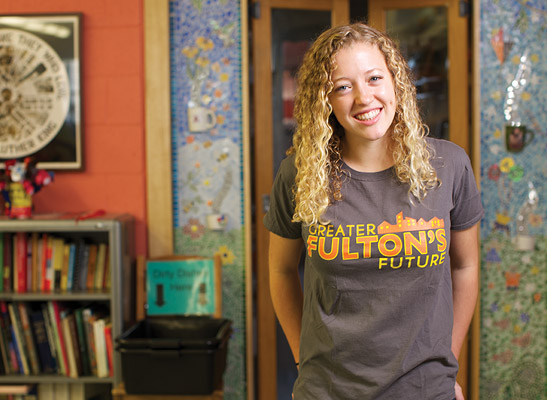
The Organizer
Amanda Lineberry, ’14
Mechanicsville, Va.
Amanda Lineberry has a photo on her laptop she absolutely loves. You can’t see the face of the boy in the image as he walks away in a black ballcap, white T-shirt, and camouflage shorts. What catches her eye is his bright blue Transformers 3D backpack.
She points at the photo. “This kid came to this community celebration and has this backpack because of something I did.” As she finishes the sentence, she is pointing right at her own heart.
It’s a heart that has grown fond of a community called Greater Fulton on the eastern outskirts of Richmond. Though Lineberry grew up a 15-minute drive away, she’d never been in the struggling community until her summer fellowship with the Neighborhood Resource Center of Greater Fulton.
There, she saw steps forward and a few missteps in the work of community organizers. The backpack was one of hundreds of school supplies distributed during a celebration she planned, doing everything from filing parade permits to hiring cops and recruiting a fire truck for the parade.
“The experience I had this summer made my education real. It’s no longer in a book,” she says. “My summer in Fulton has blended everything together and messed everything up and made it more beautiful.”
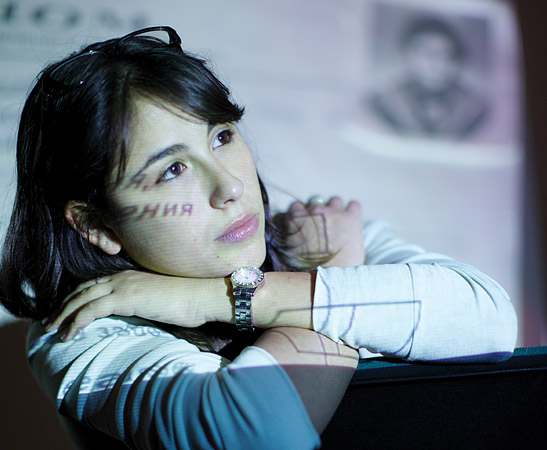
The Chronicler
Shir Bodner, ’12
Woodbury, N.Y.
“When did you start to think of yourself as American?” Shir Bodner asked the 80-year-old woman in front of her.
The woman, Lena, was one of roughly 800 refugees who fled the Soviet Union as it crumbled, resettling in the Richmond area with the help of Jewish Family Services.
Twenty years later, Bodner was interning with JFS to help launch a film project and museum-quality exhibit documenting the resettlement effort. Lena, the first interview subject, had welcomed the crew into her home with the warmth of a grandmother.
Bodner had prepared diligently, but she wasn’t prepared for Lena’s answer: When they closed the door of the airplane in Moscow, Lena said, the flight attendant announced that they were now under the protection of the U.S. government. In that moment, she felt American. Everyone in the living room teared up as she told the story.
On Bodner’s mind that day was, no doubt, her own grandmother, now 97, who emigrated from the Ukraine many decades earlier.
“This makes politics personal,” Bodner says. “This intertwines with my family story.”
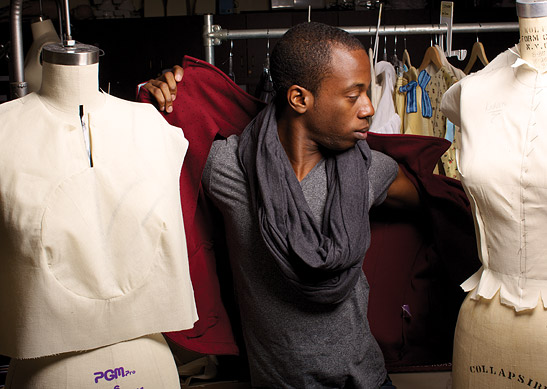
The Designer
Kadeem Alphanso Fyffe, ’13
Durham, N.C.
“Why would I rush something that is meaningful to me?” Kadeem Alphanso Fyffe asks a visitor to his Modlin Center studio.
What is more meaningful to Fyffe than anything is fashion design. At UR, he’s cut his own path through the curriculum to explore it. That initiative brought him to a semester in Italy and backstage at Milan Fashion Week, the high holy days of the Italian fashion calendar. He fitted and photographed models, kept up with rapid-fire demands in Italian, yet remained unfazed by the whirlwind.
As he looked around at top models and up-and-coming designers, another question emerged: What does it mean that I’m so close to these people?
“It reminded me that this is what I’m supposed to be doing,” he says back in his Modlin studio. “My focus is on shaping myself as a designer and making sure everything I do relates to that.”

The Player
Jolmi Minaya, ’13
Lawrence, Mass.
In life and on the mound, Spider pitcher Jolmi Minaya is a risk-taker.
With a fastball that tops 90 mph and a slider that makes hitters look foolish, he lays it on the line with every pitch. He notched seven strikeouts in relief in 2012, but he also walked seven batters. Risk and reward.
In another uniform, his corporate suit and tie, he’s as cautious as they come, pouring over balance sheets as an intern with KPMG, a big-four accounting firm with whom he spent the summer in Boston analyzing financial statements on an auditing team and making networking connections for the future.
Minaya’s job was to make sure everything lined up, that the financial T’s were crossed and the I’s dotted. He lends that expertise to a Richmond community health center, where he volunteers his accounting skills and serves as a Spanish and Portuguese language translator between doctors and patients.
That triple threat—internship experience, competitive instincts, and a Richmond education—sets him up to be a player on any field.

The Lighthouse Keeper
LaShonda Hanna, ’13
Nassau, Bahamas
When an infant entered this world merely drug-addicted but not blind, that was a victory for LaShonda Hanna.
During 400 hours of a summer fellowship at the drug treatment clinic Rubicon, she took what she could get. There was little on offer in the lives shattered by drug addiction, poverty, crime, and broken families that surrounded her.
What kept her up until dawn many nights, and kept her going the next day, was the unshakable knowledge that she might have been one of her clients. Every woman she met had been introduced to drugs by a boyfriend. That’s the story of Hanna’s mother, a woman who, despite an unstable life of abuse, drug-ridden environments, and HIV, instilled in Hanna the discipline and drive that landed this unlikely young Bahamian girl in a place like UR.
Mom died when Hanna was 13. “Everything she ever taught me clicked when she passed,” Hanna says.
So in the halls and quiet corners of Rubicon, Hanna didn’t see her mom in just the clients. She saw her mom in herself—smart, determined, resourceful, driven, unwilling to quit. With her internship and studies steering her to public health, she is determined to be for others what her mom was for her: a beacon of light that shows a better way.

The Influencer
Kait Walsh, ’13
Ridgewood, N.J.
Kait Walsh assumed her Klout score was going down, and she didn’t like it. What? You don’t have a Klout score?
Then it may be hard to sympathize with her broader summer drama: three whole weeks without social media.
Yes. Brutal.
In truth, it wasn’t a torture-the-interns moment at Mullen, the A-list Boston advertising agency. She and the other Mullen interns denied themselves social media as a way of better understanding how millennials use it and what this means for advertisers, findings they distilled in a white paper. Walsh also worked on a Google campaign from start to finish and set up the playing field for creatives on other projects based on the research she did in the strategic planning department.
Still curious about that Klout score? In your shoes, millennials would Google it. Just ask Walsh. She’s the expert now.
Send comments about this story to magazine@richmond.edu.


